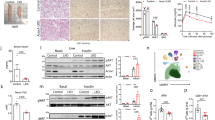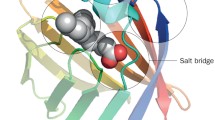Abstract
Cytosolic fatty acid binding proteins (FABPs) are widely expressed fatty acid chaperones. The adipocyte-expressed FABPs are permissive factors for the fat-induced metabolic syndrome, but a similar relevance of the FABPs of heart, muscle, and liver remains unclear. In this article, the known biochemical and physiologic roles of these FABPs are discussed in this context. It is concluded that the observations on adipocyte-expressed FABPs cannot be automatically extended to other tissues. More work is needed to clarify whether the individual or combined inhibition of FABPs is a desirable strategy to treat the metabolic syndrome.
Similar content being viewed by others
References and Recommended Reading
Moller DE, Kaufman KD: Metabolic syndrome: a clinical and molecular perspective. Annu Rev Med 2005, 56:45–62.
Wellen KE, Hotamisligil GS: Inflammation, stress, and diabetes. J Clin Invest 2005, 115:1111–1119.
Shulman GI: Cellular mechanisms of insulin resistance. J Clin Invest 2000, 106:171–176.
Unger RH: Weapons of lean body mass destruction: the role of ectopic lipids in the metabolic syndrome. Endocrinology 2003, 144:5159–5165.
Hertzel AV, Bernlohr DA: The mammalian fatty acid-binding protein multigene family: molecular and genetic insights into function. Trends Endocrinol Metab 2000, 11:175–180.
Storch J, Thumser AE: The fatty acid transport function of fatty acid-binding proteins. Biochim Biophys Acta 2000, 1486:28–44.
Stewart JM: The cytoplasmic fatty-acid-binding proteins: thirty years and counting. Cell Mol Life Sci 2000, 57:1345–1359.
Glatz JF, Storch J: Unravelling the significance of cellular fatty acid-binding proteins. Curr Opin Lipidol 2001, 12:267–274.
Boord JB, Fazio S, Linton MF: Cytoplasmic fatty acid-binding proteins: emerging roles in metabolism and atherosclerosis. Curr Opin Lipidol 2002, 13:141–147.
Weisiger RA: Cytosolic fatty acid binding proteins catalyze two distinct steps in intracellular transport of their ligands. Mol Cell Biochem 2002, 239:35–43. An excellent explanation of the molecular function of FABPs.
Makowski L, Brittingham KC, Reynolds JM, et al.: The fatty acid-binding protein, aP2, coordinates macrophage cholesterol trafficking and inflammatory activity. Macrophage expression of aP2 impacts peroxisome proliferator-activated receptor gamma and IkappaB kinase activities. J Biol Chem 2005, 280:12888–12895.
Shen WJ, Sridhar K, Bernlohr DA, Kraemer FB: Interaction of rat hormone-sensitive lipase with adipocyte lipid-binding protein. Proc Natl Acad Sci U S A 1999, 96:5528–5532. First demonstration that an FABP interacts specifically with an enzyme.
Hagens G, Masouye I, Augsburger E, et al.: Calcium-binding protein S100A7 and epidermal-type fatty acid-binding protein are associated in the cytosol of human keratinocytes. Biochem J 1999, 339:419–427.
Wolfrum C, Borrmann CM, Borchers T, Spener F: Fatty acids and hypolipidemic drugs regulate peroxisome proliferatoractivated receptors alpha- and gamma-mediated gene expression via liver fatty acid binding protein: a signaling path to the nucleus. Proc Natl Acad Sci U S A 2001, 98:2323–2328. First demonstration that an FABP can directly activate a transcription factor.
Tan NS, Shaw NS, Vinckenbosch N, et al.: Selective cooperation between fatty acid binding proteins and peroxisome proliferator-activated receptors in regulating transcription. Mol Cell Biol 2002, 22:5114–5127.
Jenkins-Kruchten AE, Bennaars-Eiden A, Ross JR, et al.: Fatty acid-binding protein-hormone-sensitive lipase interaction. Fatty acid dependence on binding. J Biol Chem 2003, 278:47636–47643.
Hanhoff T, Lucke C, Spener F: Insights into binding of fatty acids by fatty acid binding proteins. Mol Cell Biochem 2002, 239:45–54.
Haunerland NH, Spener F: Fatty acid-binding proteins: insights from genetic manipulations. Prog Lipid Res 2004, 43:328–349.
Hotamisligil GS, Johnson RS, Distel RJ, et al.: Uncoupling of obesity from insulin resistance through a targeted mutation in aP2, the adipocyte fatty acid binding protein. Science 1996, 274:1377–1379. First demonstration that an FABP affects insulin sensitivity.
Uysal KT, Scheja L, Wiesbrock SM, et al.: Improved glucose and lipid metabolism in genetically obese mice lacking aP2. Endocrinology 2000, 141:3388–3396.
Makowski L, Boord JB, Maeda K, et al.: Lack of macrophage fatty-acid-binding protein aP2 protects mice deficient in apolipoprotein E against atherosclerosis. Nat Med 2001, 7:699–705.
Maeda K, Uysal KT, Makowski L, et al.: Role of the fatty acid binding protein mal1 in obesity and insulin resistance. Diabetes 2003, 52:300–307.
Maeda K, Cao H, Kono K, et al.: Adipocyte/macrophage fatty acid binding proteins control integrated metabolic responses in obesity and diabetes. Cell Metab 2005, 1:107–119. Demonstration that simultaneous lack of A- and K-FABP, which are expressed in fat but not muscle or liver, can prevent major manifestations of the metabolic syndrome not only in fat tissue but also in muscle and liver.
Coe NR, Simpson MA, Bernlohr DA: Targeted disruption of the adipocyte lipid-binding protein (aP2 protein) gene impairs fat cell lipolysis and increases cellular fatty acid levels. J Lipid Res 1999, 40:967–972.
Scheja L, Makowski L, Uysal KT, et al.: Altered insulin secretion associated with reduced lipolytic efficiency in aP2-/-mice. Diabetes 1999, 48:1987–1994.
Shaughnessy S, Smith ER, Kodukula S, et al.: Adipocyte metabolism in adipocyte fatty acid binding protein knockout mice (aP2-/-) after short-term high-fat feeding: functional compensation by the keratinocyte fatty acid binding protein. Diabetes 2000, 49:904–911.
Samuel VT, Liu ZX, Qu X, et al.: Mechanism of hepatic insulin resistance in non-alcoholic fatty liver disease. J Biol Chem 2004, 279:32345–32353.
Kershaw EE, Flier JS: Adipose tissue as an endocrine organ. J Clin Endocrinol Metab 2004, 89:2548–2556.
Desvergne B, Michalik L, Wahli W: Be fit or be sick: peroxisome proliferator-activated receptors are down the road. Mol Endocrinol 2004, 18:1321–1332.
Kintscher U, Law RE: PPARgamma-mediated insulin sensitization: the importance of fat versus muscle. Am J Physiol Endocrinol Metab 2005, 288:E287-E291.
Binas B, Danneberg H, McWhir J, et al.: Requirement for the heart-type fatty acid binding protein in cardiac fatty acid utilization. FASEB J 1999, 13:805–812.
Murphy EJ, Barcelo-Coblijn G, Binas B, Glatz JF: Heart fatty acid uptake is decreased in heart fatty acid-binding protein gene-ablated mice. J Biol Chem 2004, 279:34481–34488.
Shearer J, Fueger PT, Rottman JN, et al.: Heart-type fatty acidbinding protein reciprocally regulates glucose and fatty acid utilization during exercise. Am J Physiol Endocrinol Metab 2005, 288:E292-E297.
Schaap FG, Binas B, Danneberg H, et al.: Impaired long-chain fatty acid utilization by cardiac myocytes isolated from mice lacking the heart-type fatty acid binding protein gene. Circ Res 1999, 85:329–337.
Erol E, Cline GW, Kim JK, et al.: Nonacute effects of H-FABP deficiency on skeletal muscle glucose uptake in vitro. Am J Physiol Endocrinol Metab 2004, 287:E977-E282.
Binas B, Han XX, Erol E, et al.: A null mutation in H-FABP only partially inhibits skeletal muscle fatty acid metabolism. Am J Physiol Endocrinol Metab 2003, 285:E481-E489.
Shearer J, Fueger PT, Bracy DP, et al.: Reduced muscle-type fatty acid binding protein (FABP) protects against diet-induced insulin resistance. ADA Annual Meeting 2004, Abstract 1401-P.
Randle PJ: Regulatory interactions between lipids and carbohydrates: the glucose fatty acid cycle after 35 years. Diabetes Metab Rev 1998, 14:263–283.
Sugden MC, Bulmer K, Holness MJ: Fuel-sensing mechanisms integrating lipid and carbohydrate utilization. Biochem Soc Trans 2001, 29:272–278.
Petersen AM, Pedersen BK: The anti-inflammatory effect of exercise. J Appl Physiol 2005, 98:1154–1162.
Newberry EP, Xie Y, Kennedy S, et al.: Decreased hepatic triglyceride accumulation and altered fatty acid uptake in mice with deletion of the liver fatty acid-binding protein gene. J Biol Chem 2003, 278:51664–51672.
Erol E, Kumar LS, Cline GW, et al.: Liver fatty acid binding protein is required for high rates of hepatic fatty acid oxidation but not for the action of PPARalpha in fasting mice. FASEB J 2004, 18:347–349.
Lam TK, Carpentier A, Lewis GF, et al.: Mechanisms of the free fatty acid-induced increase in hepatic glucose production. Am J Physiol Endocrinol Metab 2003, 284:E863-E873.
Lee SS, Pineau T, Drago J, et al.: Targeted disruption of the alpha isoform of the peroxisome proliferator-activated receptor gene in mice results in abolishment of the pleiotropic effects of peroxisome proliferators. Mol Cell Biol 1995, 15:3012–3022.
Brouillette C, Bosse Y, Perusse L, et al.: Effect of liver fatty acid binding protein (FABP) T94A missense mutation on plasma lipoprotein responsiveness to treatment with fenofibrate. J Hum Genet 2004, 49:424–432.
Zammit VA: Insulin stimulation of hepatic triacylglycerol secretion in the insulin-replete state: implications for the etiology of peripheral insulin resistance. Ann N Y Acad Sci 2002, 967:52–65.
Hajri T, Han XX, Bonen A, Abumrad NA: Defective fatty acid uptake modulates insulin responsiveness and metabolic responses to diet in CD36-null mice. J Clin Invest 2002, 109:1381–1389.
Baar RA, Dingfelder CS, Smith LA, et al.: Investigation of in vivo fatty acid metabolism in AFABP/aP2(-/-) mice. Am J Physiol Endocrinol Metab 2005, 288:E187-E193.
Semenkovich CF: Fatty acid metabolism and vascular disease. Trends Cardiovasc Med 2004, 14:72–76.
Basciano H, Federico L, Adeli K: Fructose, insulin resistance, and metabolic dyslipidemia. Nutr Metab (Lond) 2005, 21, 2:5.
Author information
Authors and Affiliations
Rights and permissions
About this article
Cite this article
Binas, B. Heart and liver fatty acid binding proteins and the metabolic syndrome. Current Science Inc 7, 401–406 (2005). https://doi.org/10.1007/s11906-005-0033-0
Issue Date:
DOI: https://doi.org/10.1007/s11906-005-0033-0




